The combination of the Red Chili Pepper Flakes and Fish Sauce gave this sauce an unforgettable kick.
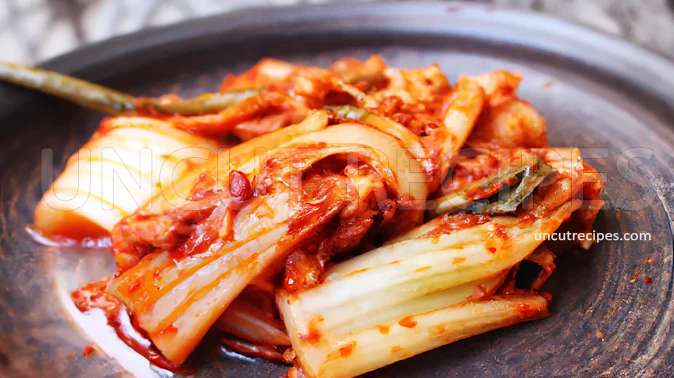
Kimchi! It's a word that resonates with flavor, tradition, and the art of Korean culinary creativity. But what makes this fermented dish so magical and captivating to the palate? It's all in the sauce, the lifeline that breathes life into an age-old favorite. And today, you'll be the conductor of this flavorful symphony, orchestrating a culinary masterpiece that spans generations and reaches into the heart of Korean cuisine.
Introducing our Kimchi Sauce recipe, a melody of flavors that marries the ocean's briny notes of salted shrimp with the earthy warmth of Korean red chili pepper flakes. It's a story told in tastes and textures, with each ingredient playing its role in a dance of savory, spicy, and umami-rich notes.
Imagine walking through a bustling market in Seoul, where the colors, scents, and sounds create a tapestry of cultural richness. The air is filled with the tantalizing aroma of freshly made kimchi, and the chatter of vendors and customers forms a comforting backdrop. That's where our sauce takes its inspiration from - the heart and soul of Korean everyday life.
The preparation of the sauce, a blend of traditional ingredients like glutinous rice powder and fish sauce, mirrors the simplicity and wisdom handed down through generations. It's a process of mixing, simmering, and blending, where patience and attention to detail yield a sauce that's both robust and refined.
Whether you're a seasoned kimchi maker or taking your first exciting steps into Korean cooking, this sauce is your gateway to an unforgettable culinary experience. It's more than just a recipe; it's a connection to a rich culinary heritage that invites you into a world of flavors that are bold, complex, and incredibly satisfying.
JUMP TO:
INGREDIENTS:
Dashima Broth (Dried Kelp) Selection: While water is a commonly used base for the sauce, using Dashima Broth adds depth and complexity to the flavor. Choose high-quality dried kelp that is clean and without blemishes. To make Dashima Broth, simmer the dried kelp in water for about 10-15 minutes. This broth enriches the sauce with umami flavors that enhance the overall taste of kimchi.
Salted Shrimp (Saeujeot) and Raw Shrimp: These are vital ingredients for authentic Korean kimchi sauce, imparting a distinctive taste. Look for fresh salted shrimp (Saeujeot) that are bright in color and have a clean smell. If salted shrimp is unavailable, you might use shrimp paste as an alternative but note that the flavor might vary slightly.
Korean Red Chili Pepper Flakes (Gochugaru): Gochugaru is essential for the characteristic spicy flavor of kimchi. Use authentic Korean red chili pepper flakes that are coarsely ground. The freshness and quality of the Gochugaru significantly affect the color and taste. Avoid substituting with other chili powders, as they will not provide the same flavor profile.
Fish Sauce (Myulchiaekjeot): This ingredient adds umami and saltiness to the sauce. Choose a quality Korean fish sauce for authenticity. If it's unavailable, you may substitute with other types of fish sauce, but be mindful of differences in flavor and salt content.
Glutinous Rice Powder Mixture: The glutinous rice powder and water mixture act as a thickening agent for the sauce. To prepare it, mix the powder with water and cook until it forms a translucent paste. This paste helps bind the ingredients and gives a pleasant texture. If glutinous rice powder is unavailable, you might try cornstarch, but the texture may vary.
Garlic and Ginger: Choose fresh garlic and ginger for robust flavors. They should be firm, free of blemishes, and aromatic. These ingredients add depth to the sauce and contribute to the overall complexity of the kimchi.
Sesame Seeds (Optional): While optional, sesame seeds can add a nutty flavor and pleasant texture. Use fresh, whole sesame seeds and toast them lightly if desired to enhance the flavor.
MAIN STEPS:
Selection of Base Liquid: Choosing between water and Dashima Broth (dried kelp) as the base for your sauce will have a substantial impact on the flavor profile. While water can create a lighter taste, Dashima Broth adds a rich umami flavor. Your choice here will depend on your preference for a more traditional and complex flavor versus a simpler taste.
Preparation of Glutinous Rice Powder Paste: Simmering the glutinous rice powder and water mixture over low heat is essential for creating the right consistency. Stirring frequently to prevent lumps and ensuring that it thickens to a thin paste are key steps. Overcooking can make it too thick and alter the sauce's texture, while undercooking may result in a grainy texture.
Adjustment of Korean Red Chili Pepper Flakes (Gochugaru): The spiciness of the sauce can be tailored to your taste by adjusting the amount of Gochugaru. The heat level varies between different brands, so it's wise to start with a smaller amount and gradually add more to achieve your preferred level of spiciness.
Minced Shrimp Handling: The fineness of the mince of both salted shrimp and raw shrimp will impact the texture of the sauce. Finely mincing or grinding ensures that the shrimp is well integrated into the sauce, providing a smooth texture. A coarse mince could lead to a chunkier sauce, which might not be suitable for all applications of kimchi.
Mixing Technique: Proper mixing ensures that all the ingredients are well combined, which helps in achieving a uniform flavor and texture throughout the sauce. Being gentle yet thorough in the mixing phase ensures that each ingredient's integrity is maintained and that the flavors meld together harmoniously.
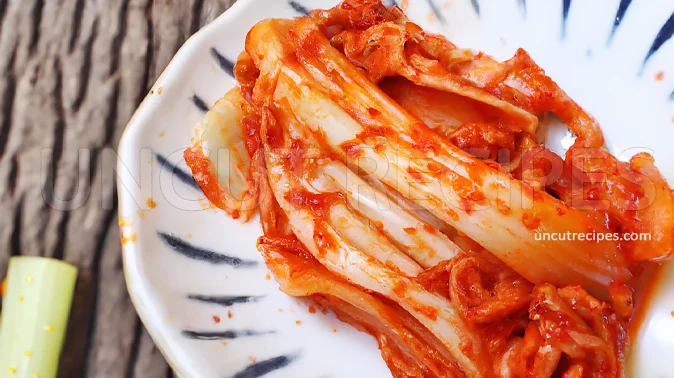
Storage and Usage Considerations: Depending on your intended use, you may want to refrigerate the sauce for later or use it immediately. Storing the sauce in an airtight container and refrigerating will help preserve its freshness and flavors for longer.
SERVED WITH:
Starter: Shrimp Gyoza (Japan): Pan-fried Japanese dumplings filled with Shrimps and vegetables. Serving them with Kimchi sauce can add a spicy and tangy twist.
Side Dish: Grilled Asparagus with Kimchi Mayo (Korea): Asparagus spears grilled and served with a mix of Kimchi sauce and mayonnaise. The sauce elevates the natural flavors of asparagus.
Main Course: Kimchi Fried Rice (Korea): A popular Korean dish made with rice, kimchi, and vegetables, often served with a fried egg on top. The Kimchi sauce is the star ingredient that gives this dish its name.
Main Course: Kimchi Tofu Stir Fry (Korea): Tofu stir-fried with vegetables and seasoned with Kimchi sauce. It offers a vegetarian option full of flavor and texture.
Second Course: Kimchi Pancakes (Korea): Savory pancakes mixed with Kimchi and other vegetables, pan-fried to golden brown. Kimchi sauce provides both moisture and flavor.
Dessert: Ginger Ice Cream (China): A refreshing ginger-flavored ice cream. The mild spice of ginger complements the heat of the Kimchi sauce in the meal.
Drink: Makgeolli (Korea): A traditional Korean alcoholic beverage made from rice. It's a milky and slightly sweet drink that can balance the spiciness of Kimchi sauce.
ALTERNATIVES:
Course: Sambal (Indonesia): Sambal is a chili sauce or paste made from a mixture of chili peppers, garlic, shallots, and lime juice. Often served with rice or noodles, it embodies the spicy and tangy notes found in Kimchi sauce but offers a unique Indonesian twist.
Course: Yum Woon Sen (Thailand): This Thai glass noodle salad includes ingredients like chili, lime juice, fish sauce, and garlic, similar to those in Kimchi sauce. It's a refreshing and spicy salad that balances sweetness, sourness, and heat.
Course: Sriracha Sauce (Thailand): Sriracha is a type of hot sauce made from chili peppers, vinegar, garlic, sugar, and salt. It's a Thai condiment that offers a different balance of sweet, spicy, and tangy flavors, used widely in various dishes.
Course: Chili Garlic Shrimp (China): This Chinese dish consists of shrimp stir-fried with garlic, chili, and ginger, similar to the ingredients in Kimchi sauce. It's a quick and flavorful seafood dish that embodies the rich and spicy notes of Asian cuisine.
Course: Banh Mi with Pickled Vegetables (Vietnam): A Vietnamese sandwich filled with meat and pickled vegetables, including carrots and radishes marinated in vinegar, sugar, and chili. It's a delightful combination of flavors that mirror the tanginess in Kimchi sauce.
Course: Ginger-Scallion Noodles (China): A simple and flavorful Chinese dish made with noodles, ginger, scallions, and soy sauce. The use of ginger connects it to the flavors of Kimchi sauce, while the dish itself offers a comforting and savory taste.
Course: Peri-Peri Sauce (Portugal/Africa): Peri-Peri Sauce is made with African bird's eye chili peppers, garlic, vinegar, and sometimes citrus. It's a spicy sauce with Portuguese and African roots that shares the fiery spirit of Kimchi sauce but brings its distinct taste profile.
HISTORY:
Kimchi is an iconic Korean dish, made from fermented vegetables, usually Napa cabbage and Korean radishes, with a variety of seasonings. Kimchi sauce is a crucial component of this beloved dish, and its history intertwines with the broader history of kimchi itself.
The origins of kimchi date back at least to the Three Kingdoms period (37 BCE – 7 CE) in Korea. Early forms of kimchi were likely simple pickled or fermented vegetables. With time, as trade routes opened and new ingredients became available, the complexity of kimchi evolved.
The chili pepper, an essential ingredient in modern kimchi sauce, was introduced to Korea in the 17th century via Japan from the Americas. The incorporation of chili peppers into kimchi gave birth to the spicy, red version of the dish known today. The sauce itself is a mixture of chili pepper flakes, garlic, ginger, fish sauce, and other seasoning ingredients.
Cultural significance cannot be overstated when it comes to kimchi and its accompanying sauce. Kimchi is not just a dish but a symbol of Korean culture and identity. It's served at almost every meal and is a common side dish in Korean cuisine. The preparation and sharing of kimchi, known as "kimjang," are often family and community events. In 2013, kimjang was even inscribed on UNESCO's Representative List of the Intangible Cultural Heritage of Humanity.
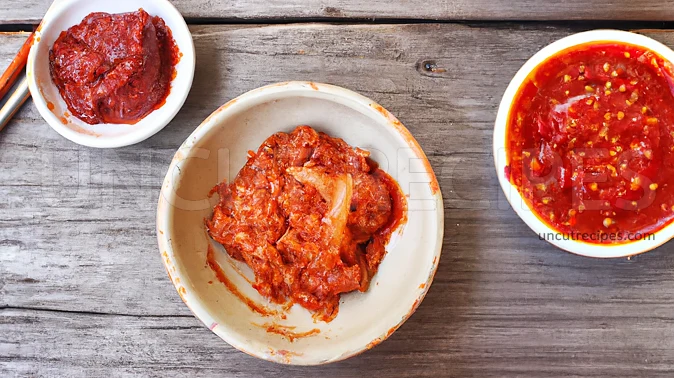
Different regions in Korea have unique takes on kimchi sauce, reflecting local preferences and available ingredients. Some regions may prefer a saltier taste, while others might opt for a sweeter or spicier version. This diversity reflects the rich cultural tapestry of Korea itself.
Today, kimchi has become popular worldwide as interest in Korean culture and cuisine has grown. The sauce, once a carefully guarded family secret, is now available in premade form, and recipes are widely shared. However, many still prefer to make it from scratch, adhering to family traditions and local customs.
TIPS:
Fermentation Twist: Experiment with a slight fermentation of the sauce. After mixing, leave the sauce at room temperature for a day or two, allowing the flavors to meld and develop a tangy complexity. This technique can give a richer, more profound flavor profile, resembling the depth found in aged Kimchi.
Use of Homemade Salted Shrimp: If you have the means and time, making your salted shrimp (Saeujeot) can allow you to control the flavor and salt content more precisely. This labor-intensive process will result in a more customized flavor.
Freshly Ground Gochugaru: Consider using whole dried Korean red chili peppers and grinding them yourself instead of store-bought Gochugaru. This will result in a fresher, more vibrant chili flavor. You can also control the coarseness according to your preference.
Incorporate Smoked Fish Sauce: Substitute regular fish sauce with smoked fish sauce to add a smoky nuance to the sauce. It can be done by smoking the fish sauce over wood chips, like cherry or oak, at low temperature. The smoky flavor can add an intriguing dimension to the sauce.
Add Fermented Seafood: Incorporate other fermented seafood products like squid or octopus. These add different layers of umami and complexity to the sauce, giving it a more distinct seafood character.
Experiment with Additional Herbs: Infuse the sauce with unique Korean herbs like Perilla leaves (Kkaennip) or Korean mint (Banga) to introduce distinct herbal notes. Make sure to balance these carefully, as they can be potent.
Customize the Thickness: Alter the consistency of the sauce by playing with the ratio of glutinous rice powder paste. A thicker sauce can be more clingy and robust, while a thinner one might be better for certain applications like marinades.
Freshly Toasted Sesame Seeds: Instead of using regular sesame seeds, toast them fresh before adding to the sauce. The toasting will release the oils and heighten the nutty flavor, adding an extra dimension to the finished product.
Create a Kimchi Sauce Reduction: Simmer the prepared sauce over low heat, allowing it to reduce into a more concentrated form. This reduction can be used as a glaze or dipping sauce, providing a more intense flavor.
Utilize Korean Sea Salt: Consider using traditional Korean sea salt (Cheonilyeom) in the preparation of the salted shrimp or even in the sauce. This can add a mineral-rich taste that's unique to the region.
Utilize the Sauce in Creative Ways: Think beyond traditional applications and use the Kimchi sauce as a base for soups, dressings, marinades, or even cocktails for a culinary adventure.
Control Texture with Shrimp Preparation: The texture of the sauce can vary dramatically depending on how the shrimp is prepared (minced, ground, or pasted). Chefs can play with these textures to create a sauce that perfectly matches the application.
Pair with Special Ingredients: Consider special pairings or applications like using the sauce with luxury ingredients like caviar or wagyu beef, creating an extraordinary fusion of flavors and textures.
Recipe Information
Skill Level
|
Time 20 Minutes |
Price
|
Serves 1 to 20 People |
| Healthiness |
Nutritional Information |
| Ratings (Add Rating & Review) |
Reviews 22 Reviews |
Ingredients:
-
0.5 cup Water
( or Dashima Broth - Dried Kelp )
0.25 cup Salted Shrimp
( Saeujeot - 새우젓 ) finely minced
4 Raw Shrimp
( finely minced or ground )
0.5 cup Korean Red Chili Pepper Flakes
( Gochugaru - 고추가루 ) adjust to your taste
3 tablespoons Fish Sauce
( Myulchiaekjeot - 멸치액젓 )
1 tablespoon Glutinous Rice Powder + 0.5 cup Water
( 찹쌀가루 )
3 tablespoons minced Garlic
1 teaspoon grated Ginger
1 teaspoon Sesame Seeds
( optional )
Allergens
| Crustaceans | Fish | Sesame | Sulphites |
Directions:
Prepare the Glutinous Rice Powder Paste:
01 - Mix the Glutinous Rice Powder and the Water (these two are listed together in the ingredients) in a pot.
02 - Simmer this mixture over low heat, stirring frequently, until it thickens to a thin paste.
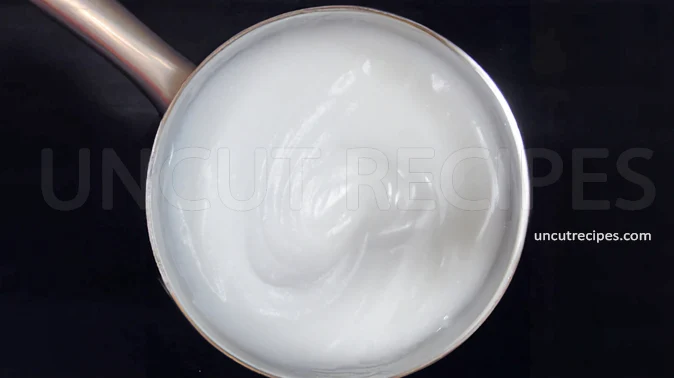
03 - Remove from heat and allow it to cool. You should end up with about 3-4 tablespoons of paste.
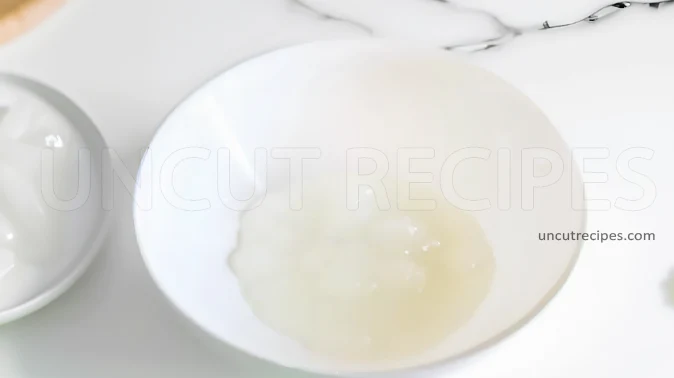
Combine All Ingredients:
04 - In a large bowl, combine the Cooled Rice Powder Paste with the Water or Dashima Broth (dried kelp).
05 - Add the finely minced salted Shrimp, finely minced or ground raw Shrimp, Korean Red Chili Pepper Flakes (adjust to your taste), Fish Sauce, minced Garlic, grated Ginger, Sesame Seeds if you're using them.
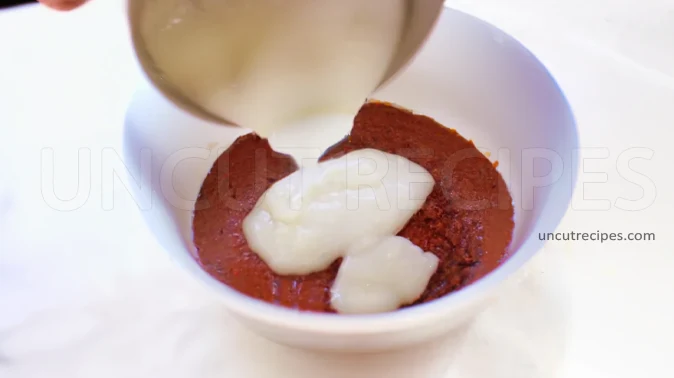
06 - Mix all the ingredients thoroughly until well combined.
Finishing:
07 - Your sauce is now finished and ready to be used. Depending on the intended use, you may wish to refrigerate it or use it immediately in your chosen dish.
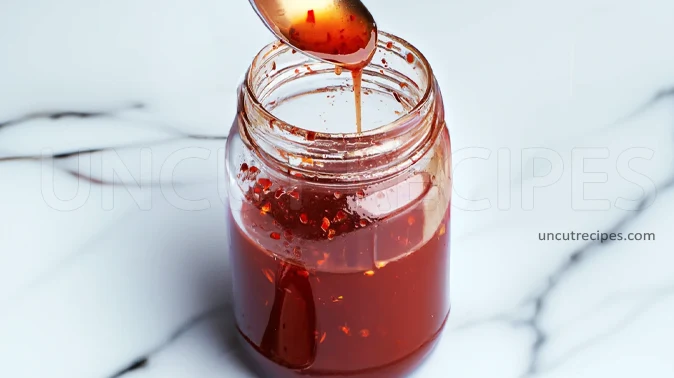
Notes:
Glutinous Rice Powder Paste: Careful attention should be paid to achieving the right consistency for the Glutinous Rice Powder Paste. It should be cooked slowly over low heat, stirring frequently to ensure it reaches a thin paste consistency without lumps.
Cooling the Paste: Ensure that the paste has sufficiently cooled before combining it with other ingredients to avoid any unwanted reactions, such as cooking the raw shrimp.
Minced Shrimp: Finely mincing or grinding the shrimp ensures a smoother consistency for the sauce. This step may require a food processor or skilled knife work.
Adjusting Spiciness: The amount of Korean Red Chili Pepper Flakes can be adjusted to your taste, and this adjustment should be considered based on the dish in which the sauce will be used.
ALTERNATIVE INGREDIENTS:
Dashima Broth Substitution: Using Dashima Broth instead of water can add depth to the flavor. Make sure to prepare the Dashima Broth beforehand if you choose to use it.
Fish Sauce Alternatives: If Myulchiaekjeot (Fish Sauce) is not available, other fish sauces could be used, but the flavor profile may change.
Optional Sesame Seeds: Including Sesame Seeds will add texture and a nutty flavor to the sauce.
STORING:
Refrigeration: If not using the sauce immediately, it should be stored in the refrigerator in an airtight container.
Shelf Life: Due to the inclusion of raw shrimp, the sauce should be used within a few days, typically 3-5, to ensure freshness.
GENERAL:
Taste and Adjust: Taste the sauce and adjust seasonings, such as the spiciness or saltiness, to achieve the desired balance for your specific application.
Usage with Kimchi: Since this is a sauce for Kimchi, it may be used in the preparation of various types of Kimchi. Depending on the specific Kimchi being made, there might be additional ingredients or preparation methods needed.
Potential Cooking Uses: Consider researching the particular dish you intend to use this sauce in, as there might be variations in the recipe tailored to that specific dish.
Hygiene: As the recipe includes raw shrimp, care should be taken to handle ingredients hygienically to prevent contamination.
Nutritional Information
( Per Portion )
|
Calories |
100 kcal (5%) |
| Total Carbohydrate | 12g (4%) |
| Cholesterol | 70mg (23%) |
|
Total Fat |
2g (3%) |
| Saturated Fat | 0.4g (2%) |
| Polyunsaturated Fat | 0.5g |
| Monounsaturated Fat | 0.5g |
| Trans Fat | 0g (0%) |
| Fibers | 1g (4%) |
| Protein | 8g (16%) |
| Sugar | 4g (16%) |
|
Vitamin A |
400 IU (8%) |
|
Vitamin B1 (Thiamin) |
0.1mg (8%) |
| Vitamin B2 (Riboflavin) | 0.1mg (8%) |
| Vitamin B3 (Niacin) | 2mg (13%) |
| Vitamin B5 (Pantothenic Acid) | 0.5mg (10%) |
| Vitamin B6 | 0.2mg (15%) |
| Vitamin B7 (Biotin) | 5mcg (17%) |
| Vitamin B9 (Folate) | 20mcg (5%) |
| Vitamin B12 | 1mcg (42%) |
| Vitamin C | 5mg (0600%) |
| Vitamin D | 0 IU (0%) |
| Vitamin E | 1mg (7%) |
| Vitamin K | 10mcg (8%) |
| Choline | 25mg (5%) |
| Carnitine | - |
|
Calcium |
60mg (6%) |
|
Chloride |
500mg (23%) |
| Chromium | 5mcg (14%) |
| Copper | 0.1mg (11%) |
| Fluoride | 1mcg |
| Iodine | 15mcg (10%) |
| Iron | 1.2mg (7%) |
| Magnesium | 30mg (7%) |
| Manganese | 0.3mg (13%) |
| Molybdenum | 5mcg (11%) |
| Phosphorus | 100mg (14%) |
| Potassium | 300mg (6%) |
| Selenium | 10mcg (18%) |
| Sodium | 2500mg (109%) |
| Sulfur | - |
| Zink | 1mg (9%) |
* Percent Daily Values are based on a 2,000 calorie diet. Your daily values may be higher or lower depending on your calorie needs.
** Nutrient information is available for all ingredients in this recipe. Amount is based on available nutrient data collected from all over the internet.
(-) Information is not currently available for this nutrient. If you are following a medically restrictive diet, please consult your doctor or registered dietitian before preparing this recipe for personal consumption. |
| Written by: Uncut Recipes | Disclaimer |


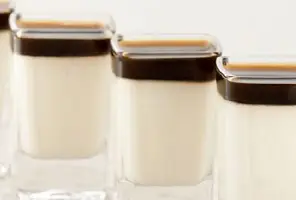
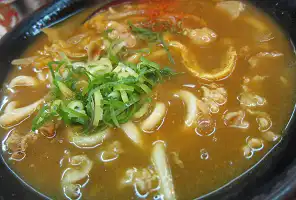
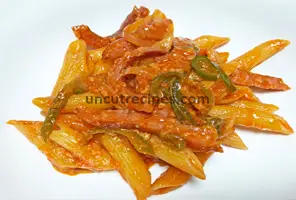
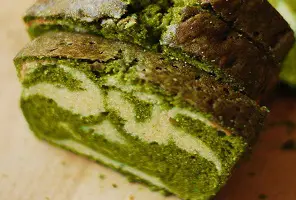
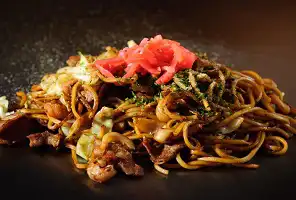

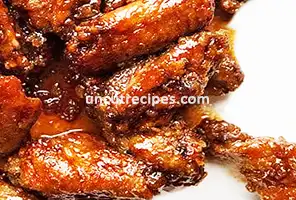

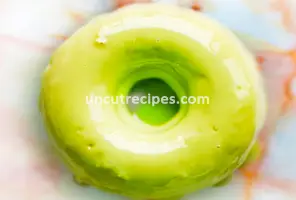
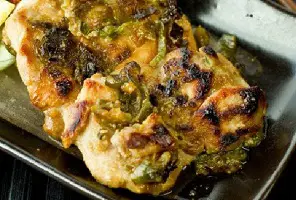


August 11, 2023
Made this Kimchi sauce for the first time, and it was a big hit! The Salted Shrimp and Raw Shrimp mixed together created an amazing taste. Even my picky eater loved it!